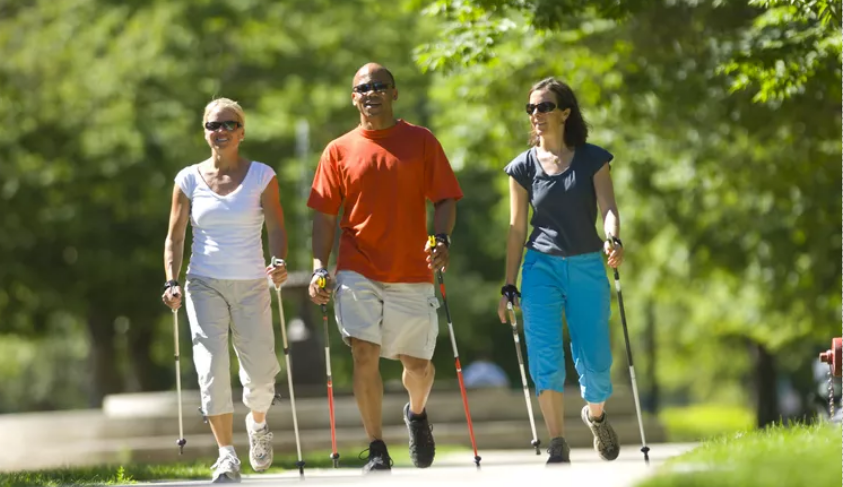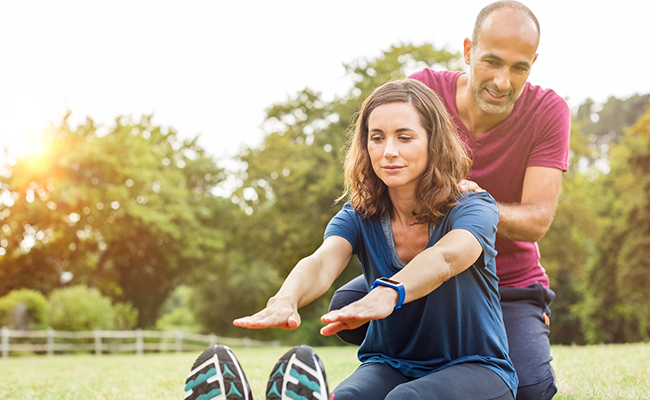Health Concerns of Outdoor Exercises
| Disclosure: The links on this page are "Affiliate Links" and while these are shown at no costs to our viewers, they generate commissions for our website(s) |

Once upon a time in my college days, I was planning on spending an afternoon after class in my dorm and reading a fiction book. Then I discovered that the day was just too beautiful to waste it away indoors, no matter how much I liked reading. Some days are just made for outdoor living, especially during the spring when the world is stepping away from the coldness of winter to truly appreciate those warmer, sunnier days. Who would want to celebrate that warmer weather by a continued winter hibernation?!
This notion can have you unhappily pursing your lips at your in-door exercise equipment on those beautiful days because even though you know that you should continue with your fitness pursuits, you just don’t want to spend such a wonderful day inside. Fortunately, there are plenty of fitness options that you can explore outside to appease both sides of the equation—your will to enjoy the day and your dedication to become fit—like running, biking, or even dragging your yoga mat into your backyard for your workout. It sounds like a great compromise, right?
It can be, no doubt, a lovely compromise, but don’t doubt that it comes with its own fault!
That fault, as it happens, is that this process has the additional complication during your workout of having elements that you wouldn’t have experienced inside of your home suddenly wreaking havoc on your skin since you’re outdoors—details like the sun beating down on you and the wind crashing against your skin. What you adored as a sunny day with a lovely spring breeze then becomes a danger zone that can cause physical damage to your skin and eyes.
The question then is this: Do these added complications mean you shouldn’t explore these outdoor opportunities?
Fortunately for the outdoor devotee, the answer to that question is a strong, “Of course not!” Rather, these complications just mean that you could use a little more planning when you decide to take your workout outdoors by knowing what dangers await you and how to combat each and every one of them. If you prepare yourself with information like this, you can embrace the outdoor world without sacrificing your health to do so.

Sunburn
The most obvious danger that you might think of for outdoor exercise is sunburn, given the amount of public attention that has recently been allotted to the complications of sun damage and the importance of sunscreen. This attention is rightly given since the health complications that can arise from sun damage can be as small as sunburn or as large as cancer. Because of this potential severity of complications, steps should definitely be taken if you plan to exercise in the sun.
For instance, choose a high SPF for your sunscreen. Remember that you’re going to be outside with the sun shining on you for a while, and you’ll need something that is strong enough to effectively protect you from start to finish. Also, pay attention to the instructions on your sunscreen. If you read through them, you might see that the sunscreen should be applied so many minutes before you’re going to be outside. If you don’t apply the sunscreen in this way, you could be hindering the effectiveness of its protection during your outdoor stay, which can lead to the aforementioned health complications.
One other thing worth noting in regard to sunburn and worse conditions that could spring from sun exposure is that your long-term health is more important than your temporary comfort. If you need to apply an extra amount of sunscreen on your forehead to keep it from sliding with your sweat to get into your eyes, protecting yourself in this way is more important than how odd you might feel with that larger amount of sunscreen (Kelly, 2015). Keep your health as a higher priority, overall, especially where the sun is concerned.
Heat Rash
Before we move away from the damage that outdoor exercise can have on your skin, let’s talk for a moment about heat rash (Matt, 2016). Essentially, this is when “your sweat ducts swell up and get blocked off due to the heat,” (Matt, 2016, “Heat Rash” section) and it can be a very real possibility when you’re working up an exercise sweat in the sun. It can also be uncomfortable and embarrassing, so it’s a thing to be aware of in order to avoid it during your outdoor regimen.
To avoid it, take breaks during your workout so that you’re giving yourself a chance to cool down (and calm down), and you might want to take note of your surroundings as you exercise to find a perfect place to take that rest. If you’re out on a run and you know you’re going to sprint by a particularly awesome shade tree, as an example, you might want to make a mental note of that detail and give yourself a break at that stage in your run.
Eye Damage
Just like the sun can have a negative effect on your skin, it can also negatively affect your eyes. One source reports that damage includes cataracts, but an ending —and worse—result can actually be the loss of sight (Vaughn, n.d.). These are not good things to have happen when you’re trying to better your health! To combat the issue, use sunglasses that are constructed to keep away damaging rays during these extended outdoor sessions. Choose options that will stay in place as you exercise for the best results, and never leave home for outdoor exercise purposes without them. Remember—health first!

Chafing
While chafing might not be limited to outdoor exercise, the addition of humidity and sunlight that can come from the outdoor setting can certainly increase the chances of having to deal with this discomfort. Essentially, the wrong circumstances “can rub your skin raw” (Matt, 2016, “Exercise Rash/Chafing” section), like unsuitable clothing and rain. There are numerous ways to help in preventing this complication, and one of the most useful methods could be the addition of “moisture-wicking clothing” (Vaugh, n.d., “#5” section) that is effective against the problem. Petroleum jelly and powder are also good options to use before you head outside for your run, bike ride, or tai chi session to lessen your chances of having to deal with this complication (Caines, n.d.). While it might not be life-threatening, chafing can certainly be irritating, so it’s a solid thing to avoid.
Dry Skin
Let’s be realistic here. You can sit in your own home and have your hands dry out. With that in mind, there’s no shock in noting that doing physical activities outside with the wind and sun pressing on you can lead to dry, damaged skin. One way to counteract this complication is to make sure that you stay hydrated, but a great strategy as well is to use some kind of moisturizer to help your skin maintain a healthier state (Vaughn, n.d.). You might also think of adding some Chap Stick to your list of exercise equipment to keep your lips from suffering that same dry fate. By noting this disadvantage to outdoor exercise and taking the right steps to correct it, you can keep your skin and lips as healthy and comfortable as they can be, even after you head back inside after your workout.

Other Sun Concerns
Keep in mind that heat rashes and dry skin, while uncomfortable, are nowhere near the worst complications that could arise by exercising outdoors. Along with the previously mentioned danger of cancer, you could also suffer a heat stroke or become dehydrated, and all of these are conditions that could prove fatal. Be sure to keep yourself hydrated and rested throughout your exercise, and keep your time spent in the sun to a safe limit so that you aren’t stepping into heat stroke territory. Enjoying the day is fine, but do so with caution!
Overall
With little to no doubt, exercising outside can provide a variation that’s appreciated in the realm of your exercise routine, but always remember that taking your routine outside comes with additional health concerns that need to be addressed. Some of these concerns are passing, like chafing, but some can be fatal. For your temporary comfort and the longevity of your life then, be sure to take these concerns seriously and plan appropriately—then enjoy your outdoor workout!
References
Caines, K. (n.d.). How to Prevent Your Legs From Chafing During Exercise. HealthyLiving . Retrieved from https://healthyliving.azcentral.com/prevent-legs-chafing-during-exercise-4841.html
Kelly, D. (2015, July 17). Pro Tips For Protecting Your Skin While Working Out In The Sun. ESPN . Retrieved from http://www.espn.com/espnw/athletes-life/article/13300949/pro-tips-protecting-your-skin-working-sun
Matt. (2016, June 22). How To Avoid Exercise Rash And Other Fitness-Related Skin Conditions. FitStyleLife . Retrieved from http://www.fitstylelife.com/2016/06/avoid-exercise-rash-fitness-related-skin-conditions/
Vaughn, A. (n.d.). Outdoor Activities Affect Our Skin. Dermveda. Retrieved from https://www.dermveda.com/learn/fitness/exercise/ou...





